
Theodore Samuel Williams was an American professional baseball player and manager. He played his entire 19-year Major League Baseball (MLB) career, primarily as a left fielder, for the Boston Red Sox from 1939 to 1960; his career was interrupted by military service during World War II and the Korean War. Nicknamed "Teddy Ballgame", "the Kid", "the Splendid Splinter", and "the Thumper", Williams is widely regarded as one of the greatest hitters in baseball history and to date is the last player to hit over .400 in a season. His .482 on-base percentage is the highest of all time.

Tyrus Raymond Cobb, nicknamed "the Georgia Peach", was an American professional baseball center fielder. A native of rural Narrows, Georgia, Cobb spent 22 seasons in Major League Baseball (MLB) with the Detroit Tigers, the last six as the team's player-manager, and finished his career with the Philadelphia Athletics. In 1936, Cobb received the most votes of any player on the inaugural ballot for the National Baseball Hall of Fame, receiving 222 out of a possible 226 votes (98.2%); no other player received a higher percentage of votes until Tom Seaver in 1992. In 1999, the Sporting News ranked Cobb third on its list of "Baseball's 100 Greatest Players."
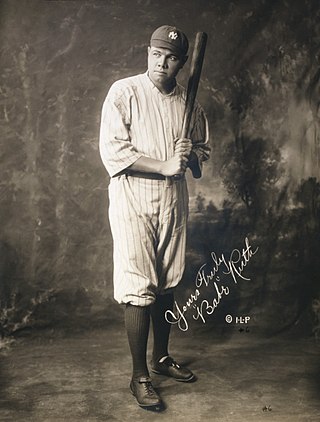
In baseball statistics, slugging percentage (SLG) is a measure of the batting productivity of a hitter. It is calculated as total bases divided by at-bats, through the following formula, where AB is the number of at-bats for a given player, and 1B, 2B, 3B, and HR are the number of singles, doubles, triples, and home runs, respectively:
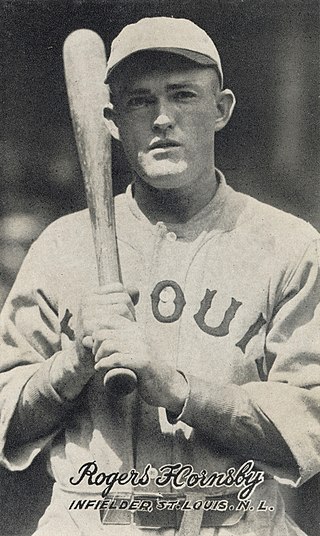
Rogers Hornsby, nicknamed "the Rajah", was an American baseball infielder, manager, and coach who played 23 seasons in Major League Baseball (MLB). He played for the St. Louis Cardinals, New York Giants (1927), Boston Braves (1928), Chicago Cubs (1929–1932), and St. Louis Browns (1933–1937). He was named the National League (NL)'s Most Valuable Player (MVP) twice, and was a member of one World Series championship team.
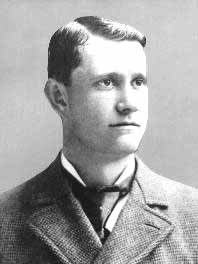
Edward James Delahanty, nicknamed "Big Ed", was an American professional baseball player, who spent his Major League Baseball (MLB) playing career with the Philadelphia Quakers, Cleveland Infants, Philadelphia Phillies, and Washington Senators. He was renowned as one of the game's early power hitters, and while primarily a left fielder, also spent time as an infielder. Delahanty won two batting titles, batted over .400 three times, and has the seventh-highest career batting average in MLB history. He was elected to the Baseball Hall of Fame in 1945. Delahanty died as a result of falling into the Niagara River or being swept over Niagara Falls (undetermined), after being removed from a train while intoxicated.

Napoléon"Nap"Lajoie, also known as Larry Lajoie, was an American professional baseball second baseman who played 21 seasons in Major League Baseball (MLB). Nicknamed "the Frenchman", he represented both Philadelphia franchises and the Cleveland Naps, the latter of which he became the namesake of, and from 1905 through 1909, the player-manager.

Francis Joseph "Lefty" O'Doul was an American professional baseball player and manager. Though he spent eleven seasons in Major League Baseball, most notably for the New York Giants and Philadelphia Phillies, he is best known for his career in the Pacific Coast League, where he was a star player and a successful manager.

Robert Hayes Veach was an American professional baseball player from 1910 to 1930 including 14 seasons in the major leagues. He was the starting left fielder for the Detroit Tigers from 1912 to 1923 and also played for the Boston Red Sox (1924–1925), New York Yankees (1925), and Washington Senators (1925).

Ira James Flagstead, sometimes known as "Pete", was an American baseball player. He played 15 years of professional baseball, principally as an outfielder, including 13 years in Major League Baseball with the Detroit Tigers, Boston Red Sox (1923–1929), Washington Senators (1929), and Pittsburgh Pirates (1929–1930). In 1,218 major league games, Flagstead compiled a .290 batting average with a .370 on-base percentage.

Duff Gordon "Sir Richard" Cooley was an American professional baseball player whose career spanned 17 seasons, 13 of which were spent in Major League Baseball (MLB). Cooley, an outfielder and first baseman, had a career batting average of .294 in 1,317 games played. He compiled 849 runs, 1,579 hits, 180 doubles, 102 triples, 26 home runs, and 557 runs batted in (RBI). In Major League history, he is tied in 148th place for most all-time triples and, his 224 career stolen bases, place him equal 279th on the all-time list. Cooley made his Major League debut at the age of 20, and spent the majority of his career there, but he also appeared in minor league baseball. After breaking his leg with the Tigers in 1905, he was replaced with future Hall of Fame outfielder Ty Cobb. Cooley, nicknamed "Sir Richard" due to his aristocratic manner, was listed as standing 5 feet 11 inches (180 cm) and weighing 158 pounds (72 kg).

William Chester "Baby Doll" Jacobson was an American baseball outfielder. He played 11 seasons of Major League Baseball, principally with the St. Louis Browns, between 1915 and 1927. He also played for the Detroit Tigers (1915), Boston Red Sox (1926–1927), Cleveland Indians (1927), and Philadelphia Athletics (1927).
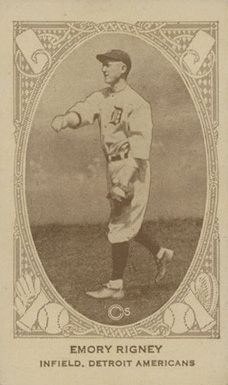
Emory Elmo "Topper" Rigney was an American professional baseball player between 1920 and 1928. He played six seasons in Major League Baseball as a shortstop for the Detroit Tigers (1922–1925), Boston Red Sox (1926–1927), and Washington Senators (1927).
The 1928 Philadelphia Athletics season involved the A's finishing second in the American League with a record of 98 wins and 55 losses. The team featured seven eventual Hall-of-Fame players: Ty Cobb, Mickey Cochrane, Eddie Collins, Jimmie Foxx, Lefty Grove, Al Simmons, and Tris Speaker.
The 1909 Detroit Tigers won the American League pennant with a record of 98–54, but lost to the Pittsburgh Pirates in the 1909 World Series, 4 games to 3. The season was their ninth since they were charter members of the American League in 1901. It was the third consecutive season in which they won the pennant but lost the World Series. Center fielder Ty Cobb won the Triple Crown and pitcher George Mullin led the league in wins (29) and winning percentage (.784).
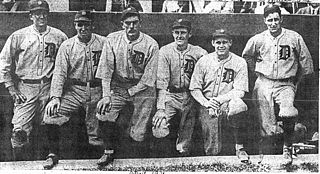
The 1921 Detroit Tigers finished in sixth place in the American League, 27 games behind the Yankees, with a record of 71–82. Despite their sixth-place finish, the 1921 Tigers amassed 1,724 hits and a team batting average of .316—the highest team hit total and batting average in American League history. Detroit outfielders Harry Heilmann and Ty Cobb finished No. 1 and No. 2 in the American League batting race with batting averages of .394 and .389, and all three Detroit outfielders ranked among the league leaders in batting average and RBIs. As early proof of the baseball adage that "Good Pitching Beats Good Hitting", the downfall of the 1921 Tigers was the absence of good pitching. The team ERA was 4.40, they allowed nine or more runs 28 times, and only one pitcher had an ERA below 4.24.
The 1911 Detroit Tigers had a record of 89–65 and finished in second place in the American League, 131⁄2 games behind the Philadelphia Athletics. They outscored their opponents 831–776, and drew 484,988 fans to Bennett Park.

In baseball, batting average (BA) is determined by dividing a player's hits by their total at-bats. It is usually rounded to three decimal places and read without the decimal: A player with a batting average of .300 is "batting three-hundred". If necessary to break ties, batting averages could be taken beyond the .001 measurement. In this context, .001 is considered a "point", such that a .235 batter is five points higher than a .230 batter.
Batting average is a statistic in cricket, baseball, and softball that measures the performance of batters. The development of the baseball statistic was influenced by the cricket statistic.


















